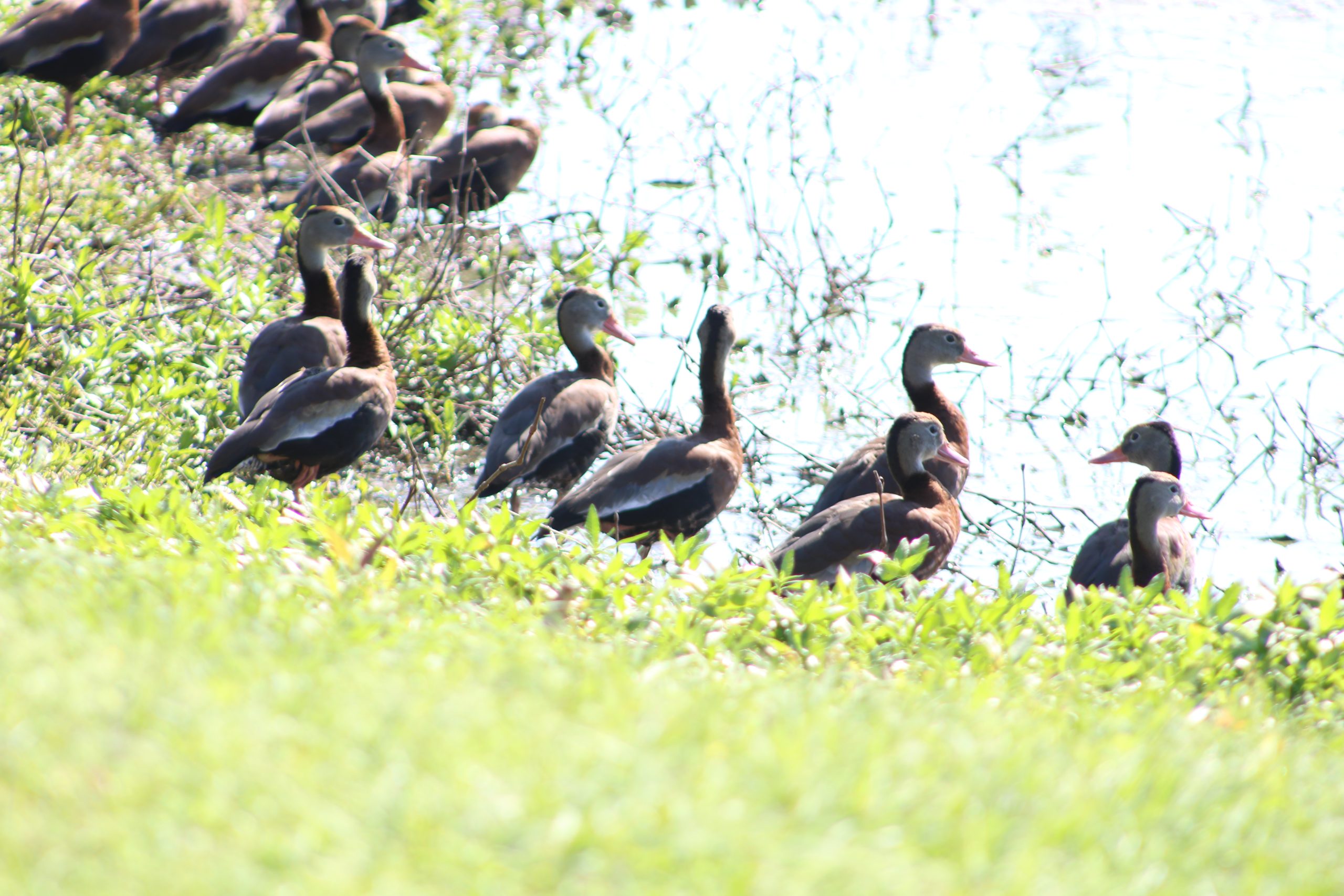Animals starting with the second letter of the alphabet represent a wide swath of the animal kingdom. A few of my favorite animals starting with the letter b include burrowing owls, bald eagles, and blue whales.
Today I will share a list of some of the many beautiful animals that start with b.
List of xx Animals That Start With B
While I couldn’t include every single animals that starts with b, I curated a list of as many as I could. The list below is a roundup of my picks for each category:
- Mammals: 19
- Birds: 40
- Reptiles: 41
- Amphibians: 20
- Fish: 41
- Invertebrates: 7
That’s a grand total of 130 animals that start with B.
Mammals: 19 Animals that Start with B
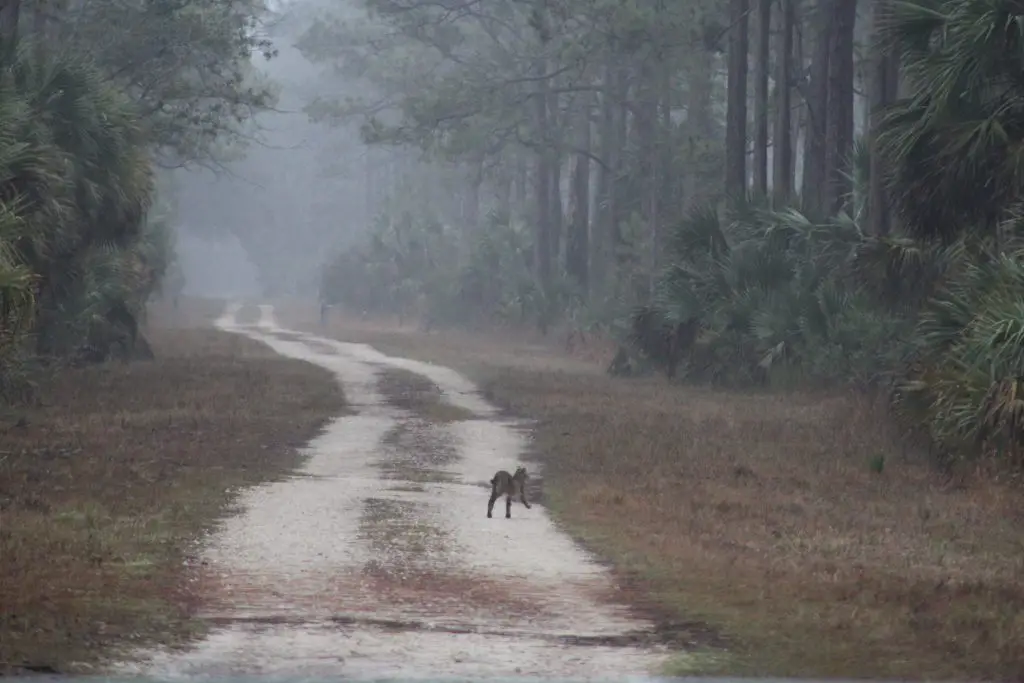
- Bobcat (Lynx rufus): A medium-sized wild cat native to North America, known for its tufted ears and short tail.
- Babirusa (Babyrousa): A wild pig species from Indonesia, known for its bizarre, upward-curving tusks.
- Bactrian Camel (Camelus bactrianus): A two-humped camel native to Central Asia, adapted for extreme desert conditions.
- Badger (Meles meles): A burrowing mammal known for its distinctive black-and-white face and strong claws.
- Baleen Whale (Mysticeti): A group of large whales, including blue whales and humpbacks, that filter-feed using baleen plates.
- Balinese Cat (Felis catus). A domesticated breed of cat with long, silky fur and blue eyes, closely related to the Siamese.
- Banded Mongoose (Mungos mungo): A small, social carnivore found in Africa, known for living in large groups.
- Bank Vole (Myodes glareolus): A small rodent native to Europe, often found in woodlands and hedgerows.
- Barbary Macaque (Macaca sylvanus): A tailless monkey found in North Africa and Gibraltar, known for its complex social structure.
- Bat (Chiroptera): The only mammals capable of sustained flight, with over 1,400 species worldwide.
- Bearded Pig (Sus barbatus): A wild pig species from Southeast Asia, recognizable by its facial whiskers.
- Beaver (Castor canadensis): A semi-aquatic rodent known for building dams and lodges in rivers and streams.
- Beluga Whale (Delphinapterus leucas): A white-colored whale found in Arctic waters, known for its expressive facial movements.
- Bengal Tiger (Panthera tigris tigris): One of the most famous tiger subspecies, native to India and Bangladesh.
- Binturong (Arctictis binturong): Also called the bearcat, this Southeast Asian mammal has a long tail and smells like popcorn.
- Black Bear (Ursus americanus): The most common bear species in North America, found in forests and mountains.
- Blackbuck (Antilope cervicapra): A striking antelope species from India with spiral horns and a contrast of black-and-white fur.
- Blue Whale (Balaenoptera musculus): The largest animal on Earth, reaching lengths of up to 100 feet.
- Bonobo (Pan paniscus). One of the closest relatives to humans, this great ape is known for its intelligence and matriarchal social structure.
Birds: 40 Animals that Start with B
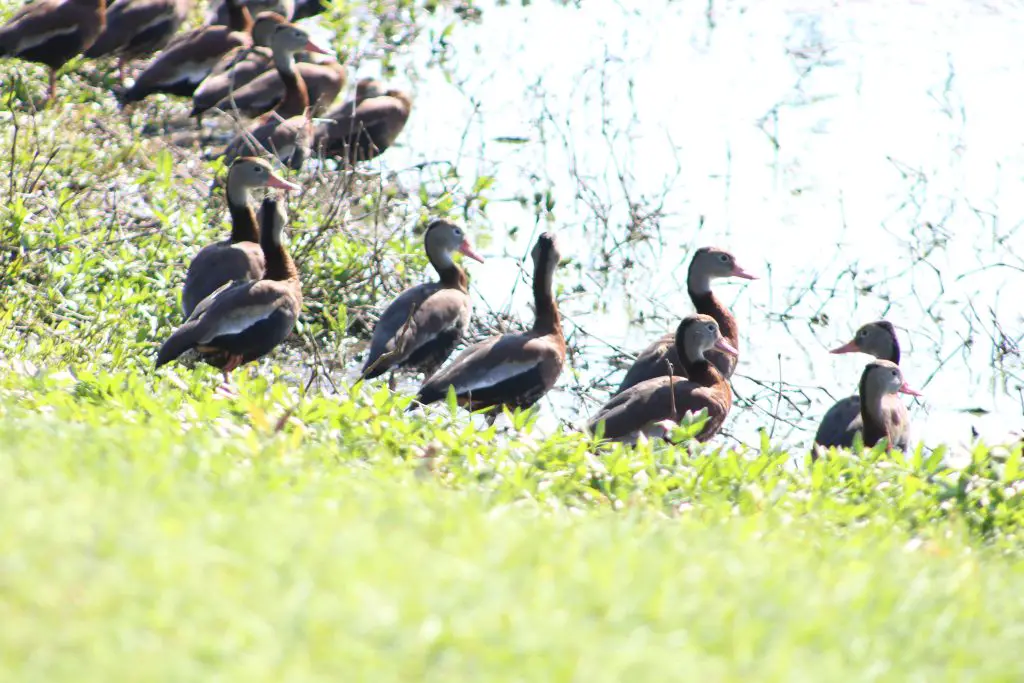
- Black-bellied Whistling Duck (Dendrocygna autumnalis). A long-legged duck with a high-pitched whistling call, found in wetlands and marshes across the southern U.S. and Central America.
- Bald Eagle (Haliaeetus leucocephalus): The national bird of the United States, known for its striking white head and powerful build.
- Barn Owl (Tyto alba). A nocturnal bird with a distinctive heart-shaped face, known for its silent flight and exceptional hunting skills.
- Baltimore Oriole (Icterus galbula): A brightly colored songbird with striking orange and black plumage, often found in North America.
- Blue Jay (Cyanocitta cristata): A highly intelligent and vocal bird, recognized for its vibrant blue feathers and mimicry skills.
- Budgerigar (Melopsittacus undulatus). A small parrot commonly known as a “budgie,” popular as a pet for its ability to mimic speech.
- Black-capped Chickadee (Poecile atricapillus): A tiny, acrobatic songbird with a distinctive black cap and cheerful call.
- Black-necked Stilt (Himantopus mexicanus): A wading bird with exceptionally long, thin legs and striking black-and-white plumage.
- Black Swan (Cygnus atratus): A stunning black-feathered swan native to Australia, known for its graceful movements.
- Blackbird (Turdus merula): A common songbird in Europe, known for its melodious song and glossy black feathers.
- Brown Pelican (Pelecanus occidentalis). A coastal bird with a large bill and throat pouch, famous for its dramatic plunge-diving fishing technique.
- Bufflehead (Bucephala albeola): A small, energetic diving duck found in North America, easily recognized by its distinctive white head patch.
- Bee-eater (Meropidae). A colorful group of birds found in tropical regions, known for their aerial acrobatics and diet of bees and other flying insects.
- Bourke’s Parrot (Neopsephotus bourkii): A small, gentle parrot with pinkish plumage, native to Australia.
- Bohemian Waxwing (Bombycilla garrulus): A beautiful bird with soft, silky plumage and a striking black mask, found in northern forests.
- Bronzed Cowbird (Molothrus aeneus). A brood parasite that lays its eggs in the nests of other birds, found in the southern U.S. and Central America.
- Black-and-white Warbler (Mniotilta varia): A distinctive warbler that creeps along tree trunks like a nuthatch, sporting bold black-and-white stripes.
- Black-throated Blue Warbler (Setophaga caerulescens): A striking blue and black songbird that migrates between North and Central America.
- Barred Owl (Strix varia). A large, round-headed owl known for its haunting “Who cooks for you?” call, found in wooded habitats across North America.
- Burrowing Owl (Athene cunicularia): A small, ground-dwelling owl that lives in burrows, often found in open grasslands and prairies.
- Broad-winged Hawk (Buteo platypterus): A migratory raptor known for its compact size and impressive long-distance flights during migration.
- Bank Swallow (Riparia riparia): A small, agile bird that nests in burrows along riverbanks and cliffs.
- Black Skimmer (Rynchops niger). A coastal bird with an unusual long lower mandible, used to skim the water’s surface for fish.
- Blue-faced Honeyeater (Entomyzon cyanotis): A striking Australian bird with a distinctive blue patch around its eyes.
- Black-headed Gull (Chroicocephalus ridibundus): A common European gull with a dark brown head in breeding plumage.
- Black Kite (Milvus migrans): A widespread bird of prey known for its soaring flight and scavenging habits.
- Black-throated Magpie Jay (Calocitta colliei). A striking blue and black bird found in Mexico, known for its long tail and social behavior.B
- ristle-thighed Curlew (Numenius tahitiensis): A rare migratory shorebird that breeds in Alaska and winters on Pacific islands.
- Blue-winged Warbler (Vermivora cyanoptera): A small North American warbler with striking yellow and blue-gray plumage.
- Barn Swallow (Hirundo rustica): A globally distributed swallow known for its forked tail and agile flight.
- Bar-tailed Godwit (Limosa lapponica): A long-distance migratory shorebird known for its non-stop flights between Alaska and New Zealand.
- Black-faced Spoonbill (Platalea minor): A rare and endangered wading bird found in East Asia, recognized by its spoon-shaped bill.
- Black-tailed Godwit (Limosa limosa): A large shorebird with a long, straight bill and distinctive black tail markings.
- Blue-throated Macaw (Ara glaucogularis): A critically endangered parrot native to Bolivia, known for its striking blue and yellow coloration.
- Buff-breasted Sandpiper (Calidris subruficollis): A small migratory shorebird that breeds in the Arctic tundra and winters in South America.
- Black-crowned Night Heron (Nycticorax nycticorax): A nocturnal wader with striking black, white, and gray plumage.
- Bay-breasted Warbler (Setophaga castanea): A North American songbird with rich chestnut-colored plumage during breeding season.
- Blue-crowned Motmot (Momotus coeruliceps): A striking tropical bird with a racket-shaped tail, found in Central and South America.
- Black-footed Albatross (Phoebastria nigripes): A large seabird known for its incredible oceanic flights and long lifespan.
- Black-backed Woodpecker (Picoides arcticus): A woodpecker adapted to burned forests, known for its striking black-and-white coloration.
Reptiles: 41 Animals that Start with B

- Black Swampsnake (Seminatrix pygaea). A non-venomous water snake found in the southeastern U.S., recognized by its glossy black body and habitat preference in swampy areas.
- Bald Uakari (Cacajao calvus). A large, rare monkey with a distinctive red face and white fur, found in the Amazon rainforest.
- Ball Python (Python regius): A popular, non-venomous snake known for its docile nature and distinctive ball-like coiling behavior when stressed.
- Bandicoot (Perameles): A small nocturnal marsupial with a pointed nose, found primarily in Australia and New Guinea.
- Barbary Leopard (Panthera pardus): A subspecies of leopard found in North Africa, known for its muscular build and distinct coat.
- Banded Palm Civet (Hemigalus derbyanus). A small mammal with banded fur, found in Southeast Asia and known for its ability to climb trees.
- Bearded Dragon (Pogona vitticeps): A popular pet lizard, native to Australia, known for its spiny beard and calm demeanor.
- Black Mamba (Dendroaspis polylepis): One of the fastest and most venomous snakes in the world, native to sub-Saharan Africa.
- Black Racer (Coluber constrictor): A fast, non-venomous snake found throughout North America, recognized for its sleek black body.
- Black-tailed Rattlesnake (Crotalus molossus): A venomous rattlesnake species found in the southwestern U.S., known for its black-tipped tail.
- Blind Snake (Typhlops): A small, burrowing snake with reduced eyes, found in various regions around the world.
- Blue Anole (Anolis allisoni): A brightly colored lizard species native to the Caribbean, known for its vibrant blue coloration.
- Blue Iguana (Cyclura lewisi). A critically endangered species of iguana found in the Cayman Islands, distinguished by its bright blue scales.
- Bog Turtle (Glyptemys muhlenbergii): A small, endangered freshwater turtle with distinctive orange markings, found in the U.S. wetlands.
- Boa Constrictor (Boa constrictor): A large, non-venomous snake known for its powerful constricting abilities, native to Central and South America.
- Blanding’s Turtle (Emydoidea blandingii): A medium-sized freshwater turtle with a yellow throat and a semi-aquatic lifestyle, found in North America.
- Blau’s Poison Frog (Dendrobatoides blau): A brightly colored amphibian with toxic secretions, found in the rainforests of South America.
- Brachylophus vitiensis (Brachylophus vitiensis). A species of lizard found in Fiji, known for its blue-green color and ability to climb trees.
- Banded Kukri Snake (Oligodon dorsalis): A small, non-venomous snake with distinctive banding, found in Southeast Asia.
- Basilisk Lizard (Basiliscus basiliscus). Also known as the “Jesus Christ lizard,” this reptile is famous for its ability to run on water.
- Brazilian Rainbow Boa (Epicrates cenchria). Known for its stunning iridescent scales, this boa species is native to the rainforests of Brazil.
- Binturong (Arctictis binturong): Though not a reptile, this nocturnal mammal is often mentioned in discussions about rare animals.
- Brownsnout Spadefoot (Spea bombifrons): A burrowing amphibian found in the central U.S., known for its distinctive spade-shaped foot.
- Banded Gecko (Coleonyx variegatus): A small, nocturnal lizard found in the southwestern U.S., easily recognized by its banded appearance.
- Black-headed Monitor (Varanus tristis). A species of monitor lizard native to Southeast Asia, recognized for its dark head and agile movements.
- Big Bend Slider (Trachemys gaigeae): A subspecies of pond turtle found in Texas and Mexico, known for its distinctive markings.
- Basilisk Gecko (Cnemaspis). A small lizard species from Africa and Southeast Asia, famous for its ability to run rapidly across surfaces.
- Blue-tongued Skink (Tiliqua spp.): A large skink species with a distinct blue tongue used to intimidate predators, native to Australia.
- Bulldog Bat (Noctilio leporinus): A large bat species found in Central and South America, known for its bulldog-like appearance.
- Banded Leaf-Tailed Gecko (Uroplatus phantasticus): A nocturnal gecko species from Madagascar, recognized for its cryptic leaf-like tail.
- Baja California Rattlesnake (Crotalus enyo): A venomous snake found in Baja California, known for its distinctive color patterns.
- Brachypelma Albopilosum (Brachypelma albopilosum): A species of tarantula native to Central America, known for its strikingly beautiful fur.
- Burmese Python (Python bivittatus): A large non-venomous snake native to Southeast Asia, known for its powerful constricting ability.
- Black Tree Monitor (Varanus beccarii): A tree-dwelling monitor lizard with striking coloration, native to New Guinea.
- Borneo River Turtle (Orlitia borneensis): An endangered species of freshwater turtle found in Borneo, known for its unique shell structure.
- Banded Sea Krait (Laticauda colubrina). A venomous sea snake recognized by its black and white bands, found in the Indo-Pacific region.
- Burrowing Frog (Heleioporus): A type of frog that spends most of its life underground, found in Australia.
- Black Spiny-tailed Iguana (Ctenosaura pectinata). A large lizard found in Central America, known for its spiny tail and ability to climb rocks.
- Boca Chica Tortoise (Gopherus): A rare species of tortoise found in the coastal regions of the southeastern United States.
- Banded Gila Monster (Heloderma suspectum): A venomous lizard found in the southwestern U.S., known for its distinct banded coloration.
- Brazilian Tegu (Tupinambis teguixin): A large, terrestrial lizard native to South America, known for its docile nature and impressive size.
Amphibians: 20 Animals that Start with U
- Banded Palm Civet (Hemigalus derbyanus). A small mammal with banded fur, found in Southeast Asia and known for its ability to climb trees.
- Barking Tree Frog (Hyla gryllus): A large, nocturnal frog found in the southeastern U.S., known for its distinctive “barking” call.
- Bicolored Frog (Dendrobatoides bicolor): A brightly colored poison dart frog species found in the tropical rainforests of South America.
- Blue Poison Dart Frog (Dendrobatoides tinctorius). A brightly colored amphibian known for its blue coloration and potent toxins, found in the rainforests of Central America.
- Boreal Chorus Frog (Pseudacris maculata). A small frog species found in North America, recognized for its rapid “chirping” call during the mating season.
- Blanchard’s Cricket Frog (Acris blanchardi). A small, brownish-grey frog with a loud call, native to the Midwest and Great Plains regions of the U.S.
- Bumblebee Toad (Melanophryniscus stelzneri). A brightly colored toad species found in South America, named for its bumblebee-like yellow and black pattern.
- Barred Tiger Salamander (Ambystoma mavortium). A terrestrial salamander native to North America, known for its dark color with yellow or orange spots.
- Brilliant Frog (Ranitomeya reticulata). A brightly colored dart frog from the Amazon Rainforest, known for its vibrant orange and yellow patterns.
- Bolivian River Frog (Telmatobius culeus). A large aquatic frog species native to South American rivers, known for its highly wrinkled skin.
- Barton’s Salamander (Eurycea bartonorum). A small, slender species of salamander found in the southeastern U.S., with a yellow or orange stripe down its back.
- Boreal Toad (Bufo boreas): A large, slow-moving toad found in the western U.S., known for its rough, warty skin.
- Black Salamander (Aneides flavipunctatus). A small amphibian species found in the northern parts of the U.S., known for its glossy black coloration.
- Balkan Frog (Rana balkanica): A frog species found in the Balkans, recognized by its distinctive greenish-brown coloration.
- Bitterling (Rhodeus sericeus): A small, colorful fish often associated with wetlands and swamps, found in the rivers of Asia.
- Baculum Frog (Hyla baculum). A frog species from Central America, often associated with tropical rainforests and recognized for its green hue.
- Black-spotted Frog (Rana nigromaculata). A large amphibian species native to eastern Asia, known for the distinctive black spots on its back.
- Bermuda Tree Frog (Eleutherodactylus ebnius). A small, nocturnal frog found in Bermuda, known for its ability to climb trees and shrubs.
- Boca Chica Toad (Incilius bocchicensis). A unique species of toad found in the southern U.S. and Mexico, recognized by its low-pitched croak.
- Boreal Wood Frog (Lithobates sylvaticus). A cold-hardy species found in northern parts of North America, known for surviving freezing temperatures during winter months.
Fish: 41 Animals that Start with U
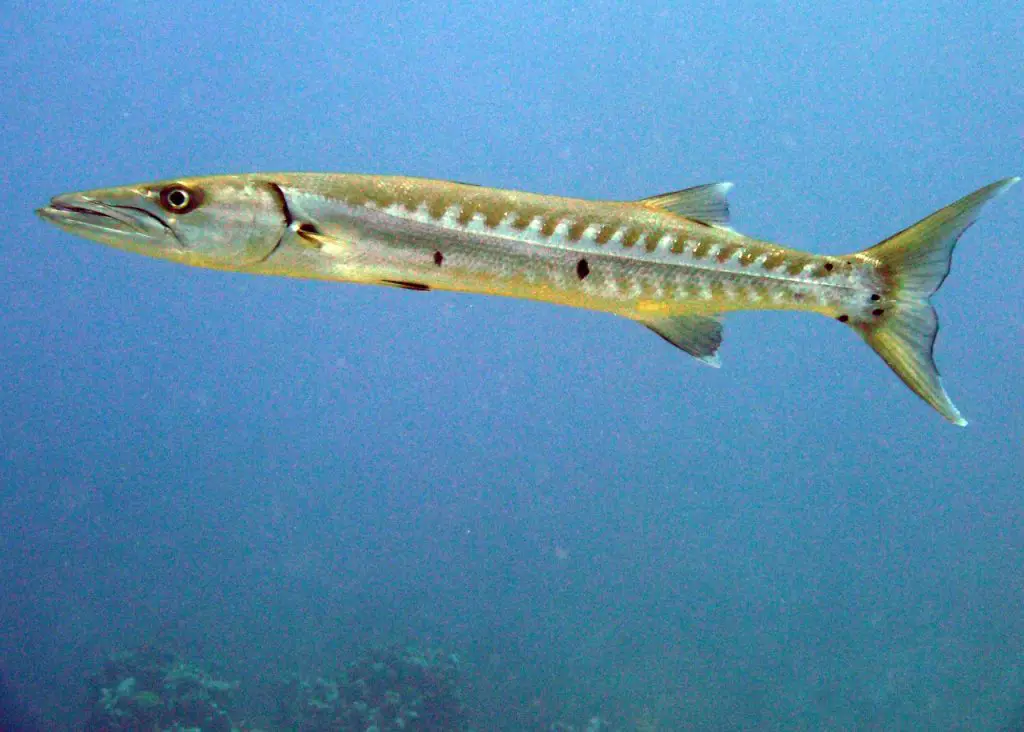
- Barracuda (Sphyraena barracuda). A predatory fish found in tropical and subtropical oceans, known for its long, sleek body, sharp teeth, and speed. It can grow up to 6 feet and preys on smaller fish like anchovies and sardines.
- Babbling Tetra (Bryconamericus affinis): A small species of freshwater fish from the Amazon basin, known for its lively schooling behavior.
- Banded Archerfish (Toxotes jaculatrix). Famous for its ability to shoot water jets at prey, this fish is native to Southeast Asia and the Indo-Pacific.
- Bala Shark (Balantiocheilos melanopterus): A popular aquarium fish with sleek, silvery body and black fins, native to Southeast Asia.
- Banded Corydoras (Corydoras metae). A small, peaceful catfish species found in the Amazon River Basin, known for its distinct banded coloration.
- Barred Knifejaw (Oplegnathus fasciatus). A species of fish found in the waters off Japan and Korea, recognized for its sharp, knife-like teeth.
- Banana Wrasse (Thalassoma lutescens). A colorful reef fish known for its vibrant yellow body and quick movements, native to the Indo-Pacific region.
- Black Bass (Micropterus): A popular freshwater fish found across North America, recognized for its aggressive nature and prized by anglers.
- Black Ghost Knifefish (Apteronotus albifrons). A nocturnal, electric fish found in South American rivers, known for its long, ghostly appearance and electric organ.
- Bluegill (Lepomis macrochirus): A sunfish species found in North American lakes and rivers, recognized by its blue-tinged gill covers.
- Bluespotted Stingray (Neotrygon kuhlii): A type of stingray found in the Indo-Pacific region, with distinctive blue spots across its back.
- Blue Tang (Paracanthurus hepatus). Also known as the “palette surgeonfish,” this brightly colored reef fish is famous for its blue and yellow coloration.
- Boca Grande Grouper (Mycteroperca jordani). A large species of grouper found in the Gulf of Mexico, valued by fishermen for its size and tasty meat.
- Brown Trout (Salmo trutta): A widely distributed freshwater fish, prized by anglers for its challenging catch and distinctive speckled pattern.
- Bristlenose Pleco (Ancistrus spp.). A small species of freshwater fish with a distinctive set of bristle-like protrusions on its face, often used in aquariums for algae control.
- Blacktip Shark (Carcharhinus limbatus). A common shark species found in the warm coastal waters of the Atlantic and Indo-Pacific, easily recognized by its black-tipped fins.
- Banded Gourami (Trichogaster fasciata): A peaceful aquarium fish with colorful vertical bands across its body, native to Southeast Asia.
- Bigfin Reef Squid (Sepioteuthis lessoniana). A species of squid found in the Indo-Pacific region, known for its ability to change color and its large, distinctive fins.
- Bitterling (Rhodeus sericeus): A small, colorful freshwater fish found in Asia and Eastern Europe, often associated with wetlands and rivers.
- Brine Shrimp (Artemia salina): Small, saltwater crustaceans often used as live feed in aquariums, recognized by their translucent bodies.
- Blotched Anthias (Pseudanthias huchtii). A colorful fish species native to the Indo-Pacific, found in coral reef ecosystems and known for its vibrant coloration.
- Ballan Wrasse (Labrus bergylta). A species of wrasse found in the Eastern Atlantic, known for its ability to change color and adapt to different environments.
- Blue Spotted Masked Puffer (Arothron reticularis). A species of pufferfish found in the Indo-Pacific, known for its unique blue spots and inflated body.
- Banded Butterflyfish (Chaetodon striatus): A beautiful reef fish with black and white vertical bands, commonly found in the Indo-Pacific region.
- Barred Catfish (Pseudoplatystoma corruscans): A large freshwater fish native to South American rivers, known for its attractive barred pattern.
- Bigmouth Buffalo (Ictiobus cyprinellus). A large species of freshwater fish native to North America, recognized for its broad head and aggressive nature.
- Bumblebee Cichlid (Pseudotropheus crabro). A small, brightly colored cichlid found in Lake Malawi, known for its black and yellow striped appearance.
- Black Marlin (Istiompax indica). A large, predatory fish found in the Indian and Pacific Oceans, known for its impressive size and speed.
- Bluefish (Pomatomus saltatrix): A predatory fish found along the Atlantic coasts, famous for its aggressive feeding habits and blue-green coloration.
- Bristletooth Tang (Ctenochaetus strigosus): A small, herbivorous reef fish found in the Indo-Pacific, recognized for the bristle-like protrusions on its body.
- Banded Crocodilefish (Cymbacephalus beauforti): A flat, camouflaged fish found in the Indo-Pacific region, known for its ability to blend into the seafloor.
- Blackfin Tuna (Thunnus atlanticus): A species of tuna found in the Atlantic Ocean, prized by commercial and recreational fishermen for its speed and size.
- Bluespotted Ribbon Tail Ray (Taeniura lymma). A small, colorful stingray with blue spots and a ribbon-like tail, found in the Indo-Pacific.
- Bumblebee Goby (Brachygobius): A tiny, vibrant fish often found in brackish water environments, with striking yellow and black stripes.
- Black-spot Angelfish (Centropyge bicolor): A small, reef-dwelling angelfish known for its black spot near the tail, found in the Indo-Pacific.
- Bagre Catfish (Bagre marinus). A species of catfish found in the Gulf of Mexico, known for its smooth body and barbed whiskers.
- Banded Knifefish (Gymnotus carapo). A species of electric fish found in South American rivers, known for its unique banded appearance and electrogenic capabilities.
- Banded Sea Krait (Laticauda colubrina). A venomous snake-like fish often found in the Pacific Ocean, known for its black and white striped body.
- Bitterling Carp (Rhodeus). A colorful and small freshwater fish found in the rivers and lakes of Europe and Asia, often admired for its vibrant color patterns.
- Black Ghost Knifefish (Apteronotus albifrons). Known for its long, ghostly tail and nocturnal habits, this fish is found in the rivers of South America.
- Bronze Tetra (Hyphessobrycon eos). A small, shiny tetra species with a bronze hue, often kept in aquariums due to its calm nature.
Invertebrates: 21 Animals that Start with B
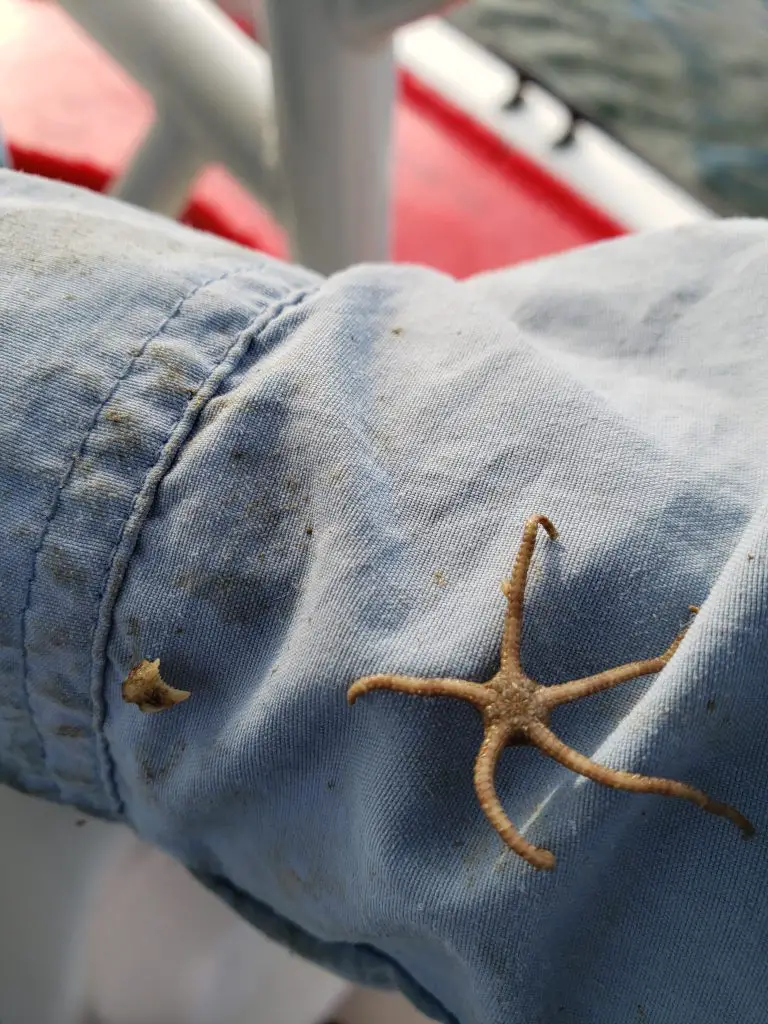
- Brittlestar (Ophiuroidea): A type of echinoderm related to starfish, known for its long, flexible arms that it uses to crawl along the ocean floor. Brittlestars are found in various marine environments.
- Black Slug (Arion ater): A large, dark-colored slug commonly found in damp, shaded areas. Known for its ability to adapt to a wide range of environments, this slug feeds on decaying vegetation and fungi.
- Bagworm (Psychidae): A family of moths whose larvae create protective cases out of twigs, leaves, and other materials, often seen hanging from tree branches.
- Barnacle (Cirripedia): Marine crustaceans that attach themselves to rocks, boats, and other surfaces. They are filter feeders and use their feathery appendages to catch plankton.
- Bumblebee Squid (Octopus cyanea). A small cephalopod found in the Indo-Pacific, known for its distinctive yellow and black striped body that resembles a bumblebee.
- Bristle Worm (Polychaeta). A group of segmented worms with bristles (setae) on each segment, found in marine environments, often living in tubes or burrows.
- Brown Recluse Spider (Loxosceles reclusa). A venomous spider found in parts of North America, known for its brown color and violin-shaped marking on its back.
- Blue Mussel (Mytilus edulis). A bivalve mollusk found in coastal waters, known for its blue shell and used in cooking, especially in Mediterranean cuisine.
- Black Widow Spider (Latrodectus mactans). A highly venomous spider with a distinctive red hourglass marking on its abdomen, found in the U.S. and parts of Mexico.
- Banded Coral Shrimp (Stenopus hispidus). A brightly colored shrimp with red and white stripes, often found in coral reefs where it scavenges for food.
- Bloodworm (Glycera spp.). The larvae of certain types of marine worms, known for their reddish color due to high hemoglobin content, often used as bait in fishing.
- Bumblebee Jellyfish (Cotylorhiza tuberculata). A species of jellyfish found in the Mediterranean, with a round, translucent bell that resembles a bumblebee’s body.
- Balloon Frogfish (Antennarius commerson). A type of anglerfish found in the Indo-Pacific region, recognized for its ability to inflate and resemble a balloon to camouflage.
- Banded Tussock Moth (Lonomia obliqua). A venomous moth species found in South America, whose larvae produce toxins capable of causing severe reactions in humans.
- Bellybutton Limpet (Crepidula fornicata). A small marine snail found along the eastern U.S. coast, named for the shape of its shell, which looks like a bellybutton.
- Bladder Snail (Physa acuta). A freshwater snail species with a thin, translucent shell, often found in ponds and lakes where it grazes on algae.
- Bivalve (Bivalvia). A class of mollusks with a hinged two-part shell, including clams, oysters, and scallops, found in both freshwater and marine environments.
- Brazilian Wandering Spider (Phoneutria fera): A highly venomous spider known for its aggressive behavior, native to Central and South America.
- Bristle-tail (Archaeognatha). A primitive order of insects, also known as jumping bristletails, they are commonly found in moist environments, including leaf litter.
- Blue Crab (Callinectes sapidus). A species of crab found along the Atlantic coast of North America, known for its blue claws and valued as a delicacy in seafood dishes.
- Brown Widow Spider (Latrodectus geometricus). A less venomous relative of the Black Widow, this spider has a geometric, light brown marking on its abdomen.
- Barred Tiger Salamander (Ambystoma mavortium). A species of amphibian often referred to as an invertebrate due to its behavior of burrowing into the ground to protect itself from environmental extremes.
- Bumblebee (Bombus). A fuzzy, hardworking insect known for its buzzing flight, bumblebees are important pollinators in gardens, meadows, and agricultural fields. They have a characteristic black and yellow body pattern and are social insects that live in colonies.
26 Animals That Start With B: A Closer Look
Below is a closer look at some of my favorite animals that start with B.
Badger
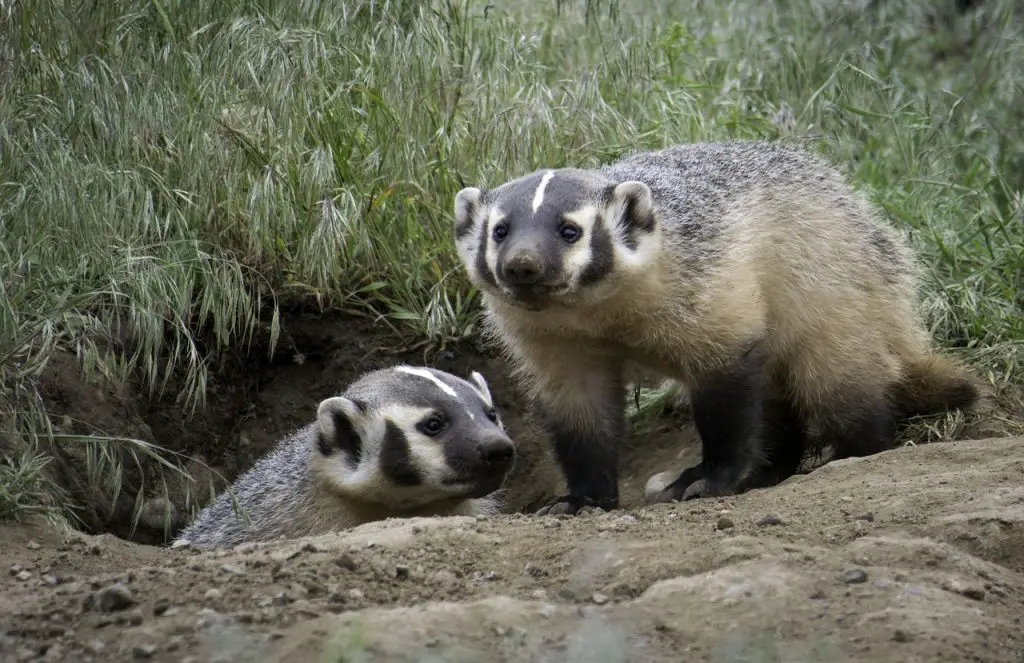
Badgers (Taxidea taxus) are medium-sized mammals known for their distinctive black-and-white facial markings. Their fur is coarse and primarily greyish-brown, providing excellent camouflage in their natural environments. Found predominantly in North America, badgers prefer open grasslands, prairies, and woodlands where they can locate their favorite prey, which includes small rodents, ground-nesting birds, and insects.
These animals have extraordinary digging ability. Equipped with strong neck muscles and long claws, they can excavate extensive burrows, called setts, which can house several generations of badgers. These setts serve as both shelter and food storage. Badgers are mostly nocturnal, emerging at dusk to hunt for food. Due to their solitary nature and nocturnal habits, they can be elusive to spot in the wild.
Black Bear

Black bears (Ursus americanus) are large mammals native to North America and are one of the most widely distributed bear species on the continent. Despite their name, their fur color can vary, ranging from black to cinnamon, blonde, or even gray-blue. They have a stocky build and rounded ears. Black bears are known for their keen sense of smell, which they use to forage for a diverse diet consisting of vegetation, fruits, nuts, insects, and occasionally small mammals.
These resourceful creatures can adapt to a variety of habitats, including forests, swamps, and even urban environments. They are skilled climbers and can effortlessly ascend trees to escape predators or reach food sources. During the winter, black bears enter a state of torpor, similar to hibernation, where they reduce their metabolic rate to conserve energy.
Despite their size and strength, black bears are generally shy and non-aggressive towards humans, preferring to avoid interactions.
Bat
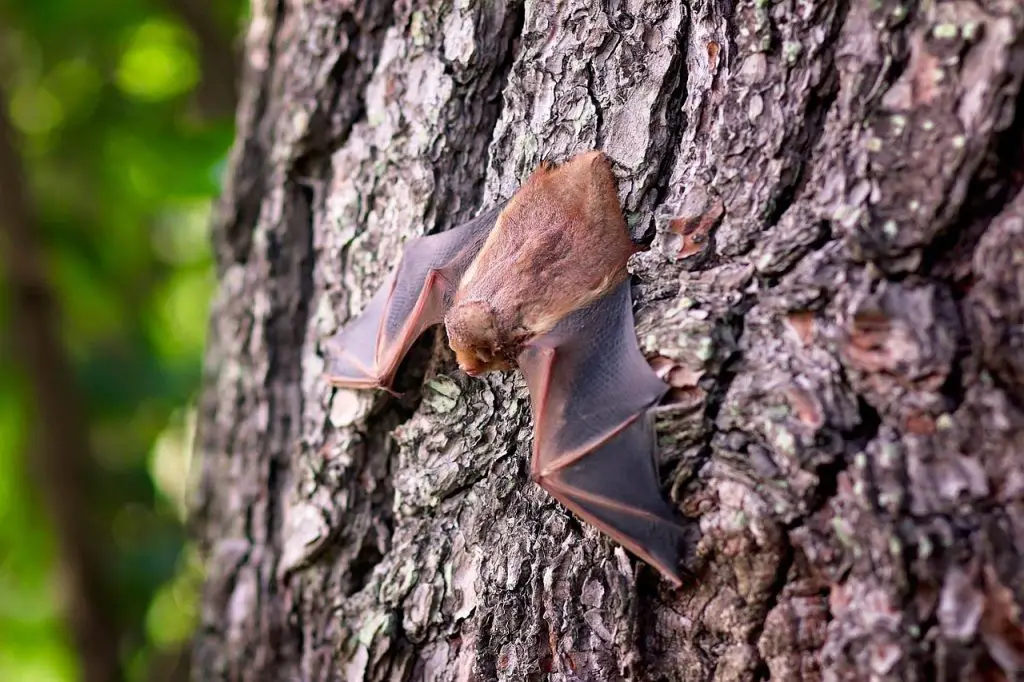
Bats are spooky creatures belonging to the order Chiroptera, making them the only mammals capable of sustained flight. With their distinctive membranous wings stretched between elongated finger bones, bats exhibit graceful aerial prowess. They vary greatly in size, ranging from tiny bumblebee bats, measuring just over an inch, to the impressive giant golden-crowned flying fox, with a wingspan of up to six feet. Despite their somewhat spooky reputation, bats play a crucial role in ecosystems as essential pollinators and insect controllers.
Many species roost in caves, while others use trees, rock crevices, and even man-made structures as their resting places. They are primarily nocturnal, taking advantage of the cover of darkness to feed on insects, nectar, fruit, or, in some cases, small vertebrates. Some bat species have evolved echolocation, emitting ultrasonic calls that bounce back from objects, allowing them to navigate and pinpoint prey with exceptional accuracy.
Bald Eagle
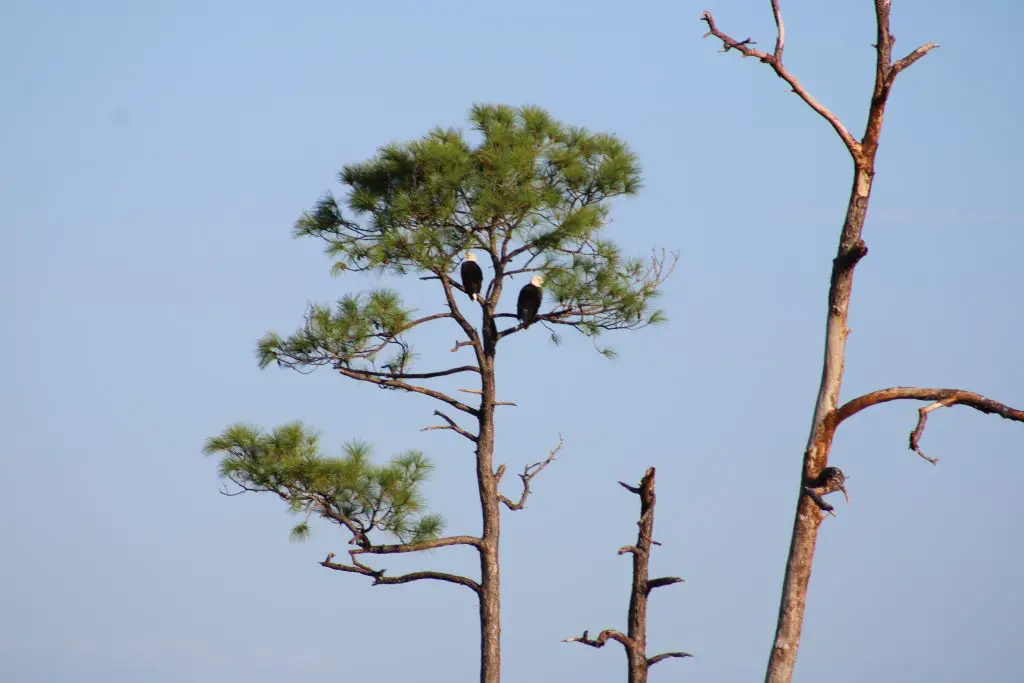
The bald eagle (Haliaeetus leucocephalus), with its striking white head and tail contrasting against a dark brown body, is an iconic symbol of strength and freedom. This magnificent bird of prey is known for its large size, with wingspans reaching up to 7 feet, making it one of the largest raptors in North America. The sharp, hooked beak and powerful talons are essential tools for hunting and catching their preferred prey, which includes fish, waterfowl, and small mammals.
Bald eagles primarily inhabit areas near large bodies of open water, such as lakes, rivers, and coastal regions. They are highly adaptable and can be found in various habitats, including forests and mountainous terrains. Additionally, they are known for building massive nests, some of which can weigh up to a ton and span several feet in diameter.
Barred Owl

The barred owl (Strix varia) is a captivating bird of prey, recognized for its striking appearance and haunting call. With its rounded facial disc and dark brown eyes, this medium-sized owl has a dignified expression. The prominent vertical bars on its chest give it the name “barred” owl. Its feathers are a mix of mottled brown, white, and gray, providing excellent camouflage in its wooded habitats. Equipped with sharp talons and a powerful beak, the barred owl is an efficient hunter, preying on small mammals, birds, and even insects.
Barred owls primarily inhabit dense forests and wooded areas across North America. They favor mature forests with a mix of open spaces, providing an ideal environment for hunting and nesting. Their exceptional adaptability has allowed them to expand their range to include urban and suburban areas as well.
Burrowing Owl
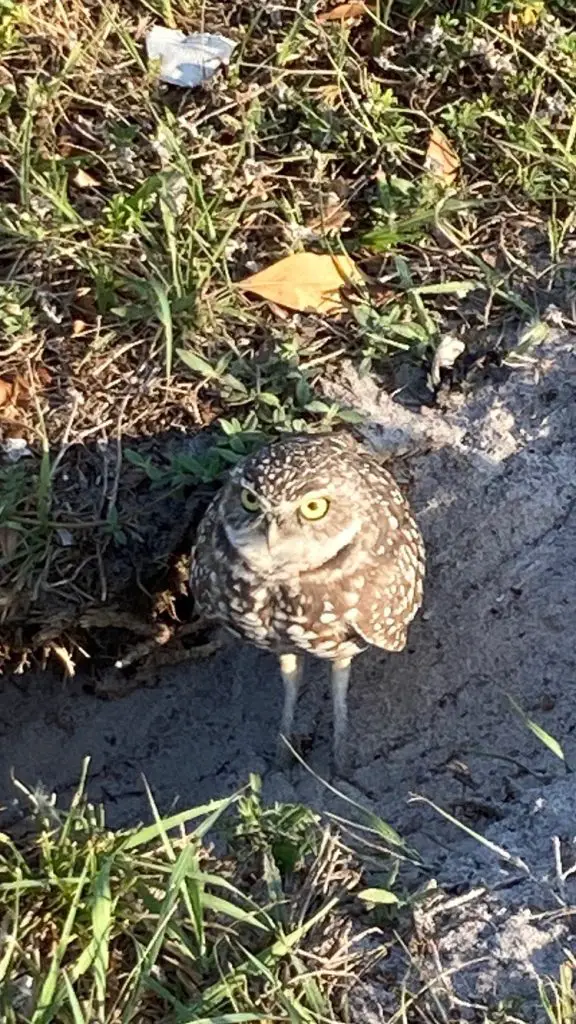
Burrowing owls (Athene cunicularia) are diminutive members of the owl family known for their unique nesting behavior. These small owls have long legs and a sandy-brown plumage with white spotting, providing excellent camouflage in their grassland habitats. Their striking yellow eyes and expressive facial features give them a curious and endearing appearance. True to their name, burrowing owls are skilled diggers and often inhabit abandoned burrows created by small mammals like prairie dogs or ground squirrels.
Burrowing owls tend to decorate their burrow entrances with objects they find in their surroundings, such as feathers, bones, and even man-made items like bottle caps or bits of plastic. This behavior is not fully understood, but it may serve a communicative or territorial purpose.
Ball Python
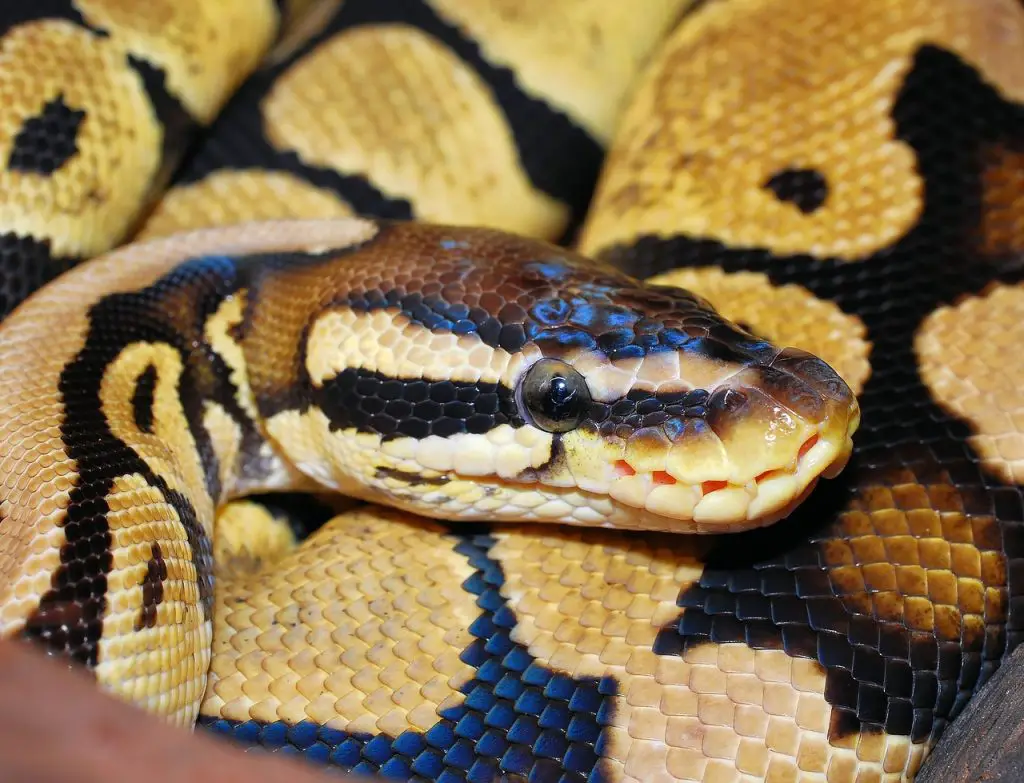
The ball python, also known as the royal python, is a popular and captivating snake species in the pet trade. With their striking patterns and gentle demeanor, they have become a favorite among reptile enthusiasts. Ball pythons (Python regius) are relatively small compared to other python species, typically reaching lengths of 3 to 5 feet. They have a robust body with a distinctive head and heat-sensitive pits on their lips, which aid in locating prey.
Native to the forests and savannas of West and Central Africa, ball pythons thrive in a variety of habitats, from grasslands to lowland forests. They are predominantly nocturnal hunters, using their excellent camouflage to ambush small mammals and birds. As their name suggests, when threatened, ball pythons have a defensive behavior of coiling into a tight ball with their head protected in the center.
Barnacle
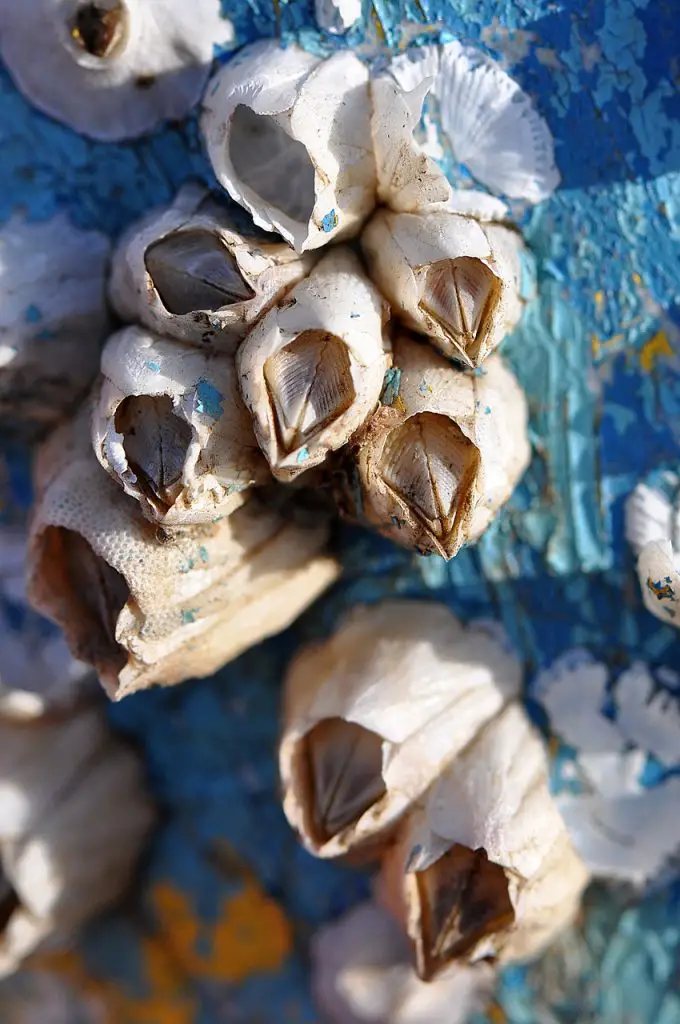
Barnacles are peculiar marine crustaceans that are permanently attached to various surfaces, such as rocks, ships, and even the skin of whales. Despite their hard, calcareous shells resembling tiny volcanoes, barnacles are actually distant relatives of crabs and lobsters. Their appearance varies depending on the species, but they generally consist of a hinged shell with feathery appendages called cirri protruding from the opening. These cirri are used to filter plankton and other microscopic organisms from the surrounding water.
Barracuda
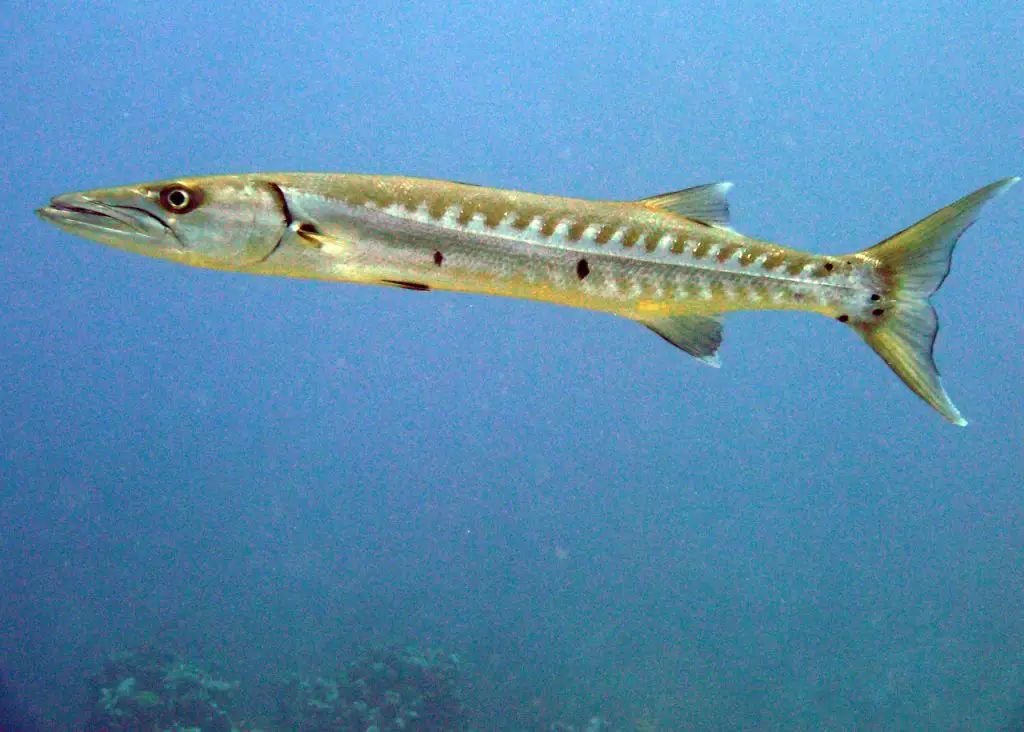
Barracudas are predatory fish found in warm waters around the world. They have a sleek and elongated body with sharp, pointed teeth, perfectly adapted for capturing and slicing through their prey with precision. Their torpedo-shaped physique allows them to reach impressive speeds, making them formidable hunters in the ocean. Barracudas come in various species, ranging in size from two to six feet or more, with the great barracuda (Sphyraena barracuda) being one of the largest and most well-known.
These voracious predators inhabit tropical and subtropical oceans, often frequenting coral reefs, coastal shelves, and open waters. They prefer areas with clear visibility, as it aids their hunting strategy of surprise attacks on smaller fish, squid, and other marine creatures.
Bed Bug
Bed bugs are small, wingless insects that have plagued human history for centuries as notorious blood-feeders. Measuring about 5-7 millimeters in length, they have a flat, oval-shaped body, which enables them to hide in tight cracks and crevices, particularly in and around beds and furniture. Bed bugs are reddish-brown in color, but they may appear darker after a blood meal. Despite their name, they can be found in various locations, not just beds, including sofas, luggage, and even electrical outlets.
Habitat preferences for bed bugs revolve around places where they have easy access to their human hosts during the night.
Blue Whale
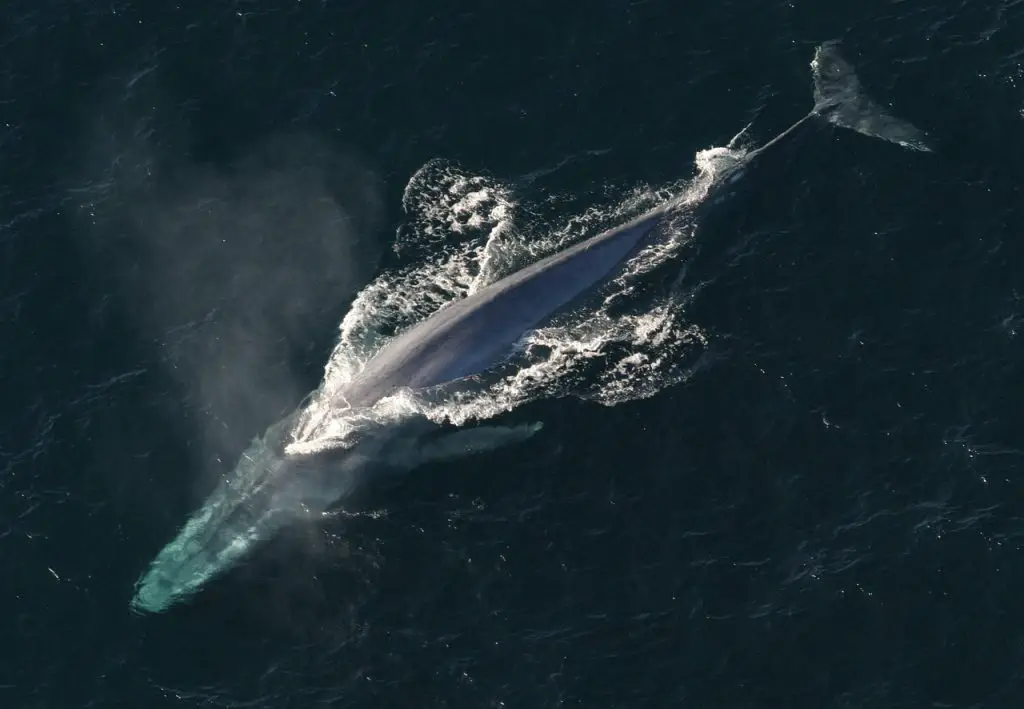
The blue whale, the largest animal to have ever lived on Earth, is a magnificent marine mammal with awe-inspiring proportions. These gentle giants can reach lengths of up to 100 feet and weigh as much as 200 tons. Their long, slender bodies are a stunning shade of blue-gray, with mottled patterns on their skin. The massive head houses a massive mouth, capable of holding hundreds of metric tons of water and krill, their primary food source.
Unfortunately, centuries of commercial whaling drastically reduced their populations, and despite protective measures implemented in the 20th century, they are slow to recover. Today, their greatest threats include ship strikes, entanglement in fishing gear, and the impact of climate change on their food sources.
Beluga Whale

Belgua, scientifically known as Beluga (Delphinapterus leucas), is a captivating marine mammal that starts with the letter “B.” This striking creature, often referred to as the white whale, boasts a distinctive appearance with its snow-white skin, making it easily recognizable among its ocean-dwelling counterparts. The Beluga’s streamlined body, rounded forehead (melon), and lack of a dorsal fin enable it to effortlessly maneuver through icy Arctic and sub-Arctic waters. These social animals display a keen intelligence, known for their complex vocalizations, earning them the moniker “sea canaries.”
During the summer months, they venture into estuaries and shallow river deltas in search of food, which mainly consists of fish, crustaceans, and cephalopods. Their strong sense of community is evident in their migrations, as they often travel in pods, ranging from a few individuals to larger aggregations.
Bowhead Whale
The bowhead whale (Balaena mysticetus) is an awe-inspiring marine mammal that claims its spot among the animals that start with the letter “B.” One of the largest whale species, the bowhead stands out with its robust, dark-colored body and massive, bowed head, which comprises almost 40% of its total length. As its name suggests, the bowhead’s distinguishing feature is its strong, arched upper jaw, which allows it to break through thick Arctic ice with ease.
Their preference for Arctic seas is partly due to the abundance of their favored food, such as krill, copepods, and small fish, which they filter through their baleen plates. Bowhead whales exhibit remarkable longevity, with some individuals believed to live for over 200 years, making them one of the longest-lived mammals on Earth.
Buffalo

The buffalo encompasses two remarkable and distinct species – the water buffalo (Bubalus bubalis) and the Cape buffalo (Syncerus caffer). The water buffalo, also known as the Asian buffalo, boasts a sturdy, dark-colored body and large, curving horns that can span over five feet. Its preferred habitat includes marshlands, swamps, and riverbanks, where it relishes in the water and mud to keep cool and protect itself from biting insects. Renowned for its vital role in Asian agriculture, the water buffalo has served as a reliable draft animal for centuries, contributing significantly to farming and transportation.
On the other hand, the Cape buffalo, also referred to as the African buffalo, exhibits a robust and formidable build, with large, sweeping horns that fuse at the base, forming a distinctive “boss” on its forehead. This imposing bovid prefers a range of habitats, from grasslands to woodlands, and is often seen in large herds grazing on grass and occasionally browsing on shrubs and trees. Remarkably social animals, Cape buffaloes establish strong bonds within their herds and demonstrate fierce protectiveness towards their young and members in need.
Black Widow Spider

The black widow spider (Latrodectus spp.) is an eye-catching arachnid. Renowned for its distinctive appearance, the female black widow is recognizable by its shiny black body with a distinctive red or orange hourglass-shaped marking on its abdomen. This spider possesses powerful neurotoxic venom, making it one of the most venomous spiders in North America.
Black widow spiders live in a range of habitats, from temperate forests to urban areas. The female black widow is notorious for its unique reproductive behavior, as it sometimes cannibalizes the male after mating, leading to the name “black widow.” Despite its potentially dangerous venom, black widow spiders usually avoid human contact, and bites are relatively rare. In the rare event of a bite, prompt medical attention is crucial.
Bison

The buffalo, scientifically known as Bison bison, is an iconic mammal that belongs to the animals starting with the letter “B.” These massive bovids sport a distinctive and robust build, with a humped shoulder and a massive head adorned with curving, sharp horns. Their thick, shaggy fur ranges in color from dark brown to black, providing them with insulation during harsh weather conditions.
Historically, buffalo herds once roamed the vast grasslands of North America in immense numbers. While their range has significantly diminished, they can still be found in various habitats, including prairies, savannas, and woodlands. Buffalo exhibit fascinating social behavior, forming tight-knit groups and displaying intricate communication within their herds.
Bobcat

The bobcat (Lynx rufus) is a medium-sized predator that boasts a distinctive appearance. They have a short, bobbed tail, tufted ears, and striking, speckled fur patterned with spots and bars, aiding in its exceptional camouflage. The bobcat’s coat coloration can vary from grayish-brown to reddish-brown, adapting to its diverse range of habitats.
These solitary creatures are found throughout North America, inhabiting a range of ecosystems, from dense forests and mountains to semi-arid regions and swamps. Bobcats are excellent hunters, preying on a variety of small to medium-sized animals, such as rabbits, rodents, and birds. With remarkable agility and keen senses, they are skilled at stalking and ambushing their prey.
Bonobo

The bonobo, scientifically known as Pan paniscus, is an intelligent member of the great ape family. Often referred to as the “pygmy chimpanzee,” the bonobo shares many physical characteristics with its close relative, the common chimpanzee. It has a slim build, covered in dark hair, and long arms ideal for swinging through the forest canopy.
Bonobos are native to the dense rainforests of the Democratic Republic of Congo in Central Africa. They are highly social animals, living in complex societies led by female dominance. One of the most unique aspects of bonobos is their exceptional emphasis on peaceful behaviors, forming strong bonds within their communities.
Box Turtle

(That’s me with a baby box turtle!)
The box turtle (Terrapene carolina) is a reptile that finds its place among the animals starting with”B.” Box turtles have a distinct appearance, featuring a high-domed carapace (upper shell) and a hinged plastron (lower shell) that allows them to close their shell tightly, protecting their vulnerable body from predators. Their carapace can vary in color, from shades of brown and olive to vibrant patterns of yellow and orange.
Box turtles are primarily found in North America and are highly adaptable to various environments. They prefer habitats with a mix of woodlands, grasslands, and moist areas, such as meadows and marshes. These terrestrial reptiles display a slow and deliberate movement, relying on their strong shell for protection rather than quick escape. They have an intriguing ability to retract their head, legs, and tail completely into their shell when they feel threatened.
Bull Frog

The bullfrog (Lithobates catesbeianus) is a frog species that exhibits a robust and muscular build. The frog has a distinctive rounded snout and powerful hind legs, ideal for long leaps and swimming. Bullfrogs are highly adaptable and can be found in a variety of aquatic habitats. Ponds, lakes, marshes, and slow-moving rivers are all fair game for these frogs. They are known for their distinctive deep, resonant calls, often likened to the sound of a bull, hence the name “bullfrog.” Their calls are particularly prominent during breeding season when males vocalize to attract females.
Bush Baby

The bush baby, scientifically known as Galago spp., is a small primate. These adorable creatures have a unique physical appearance, featuring large, round eyes that aid in their excellent night vision. They have a bushy tail, soft fur ranging in color from gray to brown, and distinctively long hind limbs, which enable them to leap great distances through the trees.
Bush babies are predominantly found in the forests and woodlands of sub-Saharan Africa. They are nocturnal animals, relying on their exceptional agility and nocturnal adaptations to navigate through the dense vegetation at night. One of the fascinating features of bush babies is their ability to communicate using various vocalizations, including soft calls, sharp barks, and loud cries, which they use to establish territories and communicate with each other.
Butterfly

Butterflies belong to the scientific Order Lepidoptera. They are delicate insects that stands out among the animals that start with B. These captivating creatures are characterized by their vibrant colors, intricate wing patterns, and delicate, membranous wings. Butterflies undergo a remarkable transformation, starting as caterpillars that undergo metamorphosis to become beautiful winged adults.
Butterflies are found in a wide range of habitats across the globe. You can find them everywhere from tropical rainforests to temperate meadows and even deserts. They are highly sensitive to environmental changes and are often considered indicators of the overall health of ecosystems. As pollinators, butterflies play a crucial role in plant reproduction, facilitating the transfer of pollen from one flower to another.
Burmese Python

The Burmese python (Python bivittatus) is a large and impressive constrictor snake. The powerful reptiles can reach lengths of up to 20 feet or more. And their robust bodies are covered in intricate patterns of dark brown or black and tan scales. One of their distinctive features is their heat-sensing pits along their upper and lower jaws, which aid them in detecting warm-blooded prey.
Burmese pythons are native to Southeast Asia, where they inhabit a variety of habitats, including forests, grasslands, and wetlands. However, they have become an invasive species in certain regions, including the Florida Everglades. Reasons for this include the pet trade and accidental or intentional releases.
Box Jellyfish

The box jellyfish (Chironex fleckeri) is a highly venomous marine creature. These gelatinous and transparent jellyfish derive their name from their square-shaped, box-like bell, which can reach sizes of up to 20 centimeters in diameter. Each corner of the bell houses a long, tentacle cluster containing thousands of tiny, venomous nematocysts used for capturing and immobilizing prey.
Baboon

The baboon is a social primate that claims its spot among the animals that start with b. These intelligent animals exhibit a robust and muscular build, with powerful limbs and distinctive dog-like muzzles. Their fur coloration varies among species, ranging from olive-green to brown and even silver-gray in certain individuals.
Baboons are highly adaptable. You can find them in various habitats across Africa, from open savannas and grasslands to dense forests and rocky cliffs. They live in large troops led by dominant males and exhibit complex social structures. Within the groups, grooming and communication play crucial roles in maintaining group cohesion.
Bumblebees

Bumblebees round out this list of animals that start with B. They are scientifically known as Bombus spp., and are essential pollinators. These fuzzy insects are characterized by their robust, black and yellow-striped bodies and their soft, audible buzzing while flying. Bumblebees exhibit a unique social structure, forming colonies led by a queen, workers, and male drones.
Bumblebees are found in a wide range of habitats, from meadows and gardens to woodlands and alpine regions. They play a vital role in pollinating a variety of flowering plants, making them essential contributors to the health and diversity of ecosystems. In terms of conservation status, certain bumblebee species are facing decline due to habitat loss, pesticide use, and climate change.
Final Take on Animals That Start With B
That’s a wrap on some of the many animals that start with the letter B. Of course, this isn’t a comprehensive list. But it’s a good place to start learning about these critters. What’s your favorite animal that starts with B?
